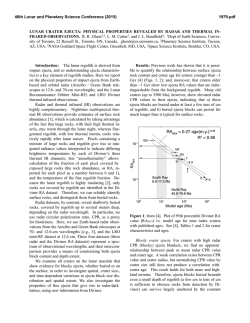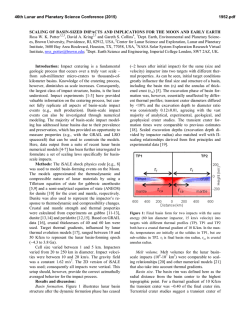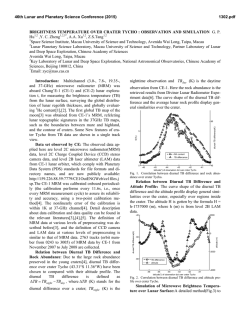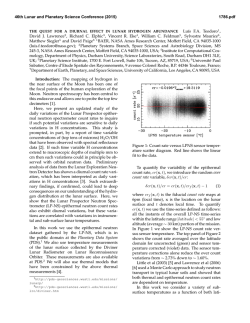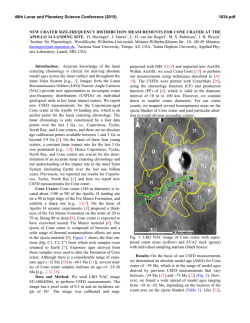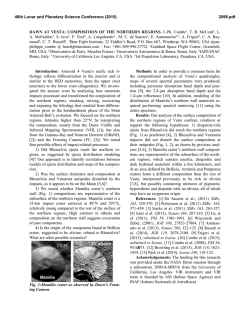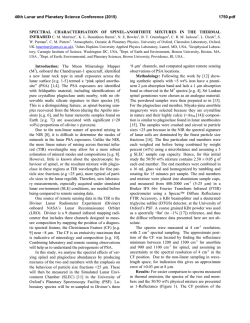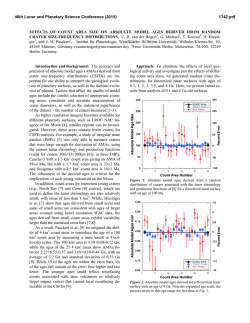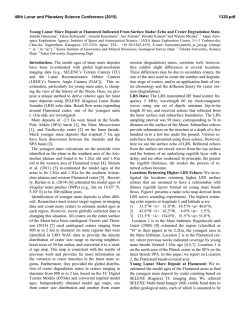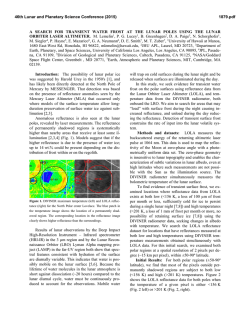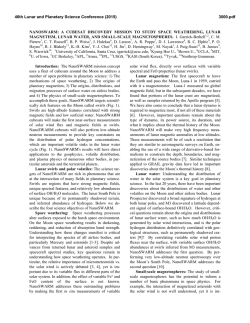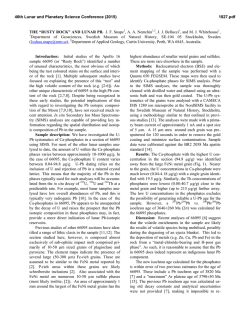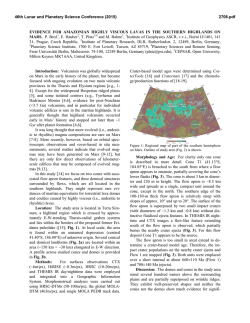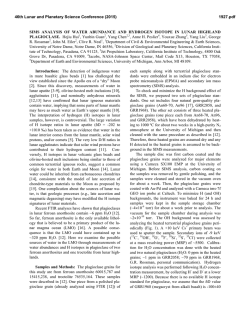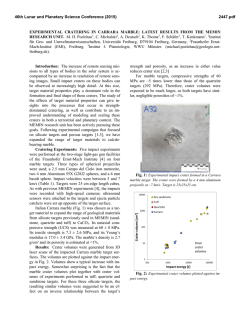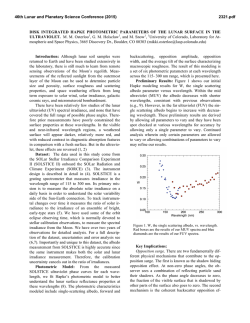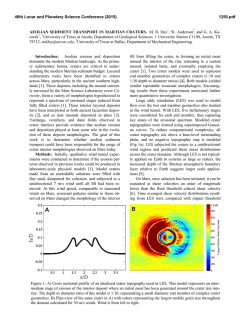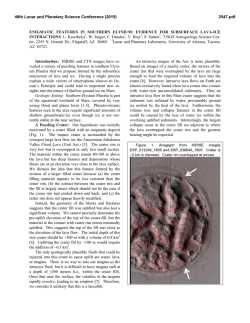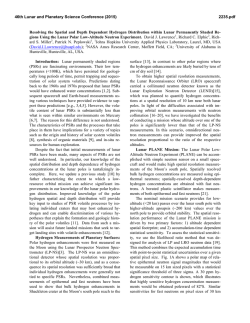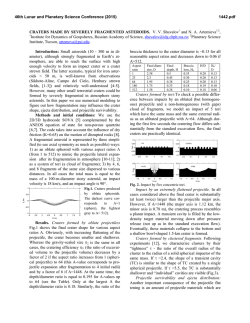
Temperatures of Giordano Bruno Crater: Application of an effective
46th Lunar and Planetary Science Conference (2015) 2777.pdf Temperatures of Giordano Bruno Crater: Application of an effective field of view model using LRO Diviner J.-P. Williams1 , E. Sefton-Nash2 , and D. A. Paige1 , 1 Earth, Planetary, and Space Sciences, University of California, Los Angeles, CA, 90095, USA ([email protected]), 2 Earth and Planetary Sciences, University of London, London, UK. Introduction: The Diviner Lunar Radiometer Experiment aboard LRO [1] acquires calibrated radiometric measurements of reflected visible and emitted infrared radiation of the Moon in 9 spectral channels covering a wavelength range of 0.3 to 400 µm and nominally points in the nadir direction operating as a multi-spectral pushbroom mapper. Observations are acquired continuously with a 0.128 s signal integration period. We present an analysis of gridded radiance measurements at Giordano Bruno, a 22 km diameter rayed crater, providing an example of our gridding procedure developed for creating the Diviner level 2 gridded data products. Brightness temperatures and anisothermality observed in Diviner’s thermal IR channels reveal heterogeneous thermophysical properties of the crater ejecta indicating minimal mechanical distruption by micrometeoroids consistent with a recent formation age. Effective Field of View (EFOV): To produce mapped data products, the data needs to be binned onto a grid. A measurement is represented by a single location on the surface; however the total radiance that contributes to a measurement derives from a finite surface area. Binning the data onto a cylindrical latitude/longitude grid can result in aliasing at high latitudes where the areal extent of the bins in longitude become increasingly smaller towards the pole. This can result in unpopulated bins that represent surface areas that contribute to the measurements being gridded. Additionally, the footprints of the detectors of the individual channels in general will not be identically aligned. This misalignment can result in artifacts in gridded data derived from multiple channels. This can be seen in Fig 1c showing Diviner channel 4 differenced with channel 7. Issues such as these are resolved by modeling the two-dimensional EFOV projected onto the surface for each observation using the Monte Carlo method prior to binning the data. For an instrument operating in a pushbroom configuration like Diviner, the EFOV may be defined by (i) the in-track time broadening due to spacecraft motion relative to the target body, (ii) the detector response as a function of time and, (iii) the instruments instantaneous field of view (IFOV) (See [2] for details). The EFOV is populated with n points and pro- Figure 1: Orbit 1479 brightness temperatures: (a) Channel 4, (b) channel 7, (c) channels 4-7, and (d) channels 4-7 using EFOV modeling. Dashed lines outline the crater rim and black boxes show location of LROC subframes in Fig 2. jected onto the surface of the target body given the detector orientation relative to North. The cloud of points will trend toward the actual EFOV as n increases, with the point density reflecting the probability distribution. Modeled points are assigned the same radiance value as the original observation and are used as input to a binning routine. Assuming a sufficiently high point density, all bins that lie within the EFOV will be populated with a value. This eliminates the occurrence of empty bins. Where adjacent detectors have overlapping EFOVs, points from different observations may reside in the same bins. The resulting radiance value of each bin is therefore the weighted mean of the observations that fall within it. Diviner channels also become better aligned as can be seen in Fig 1d where speckling in the temperature difference map is eliminated. Brightness Temperatures at Giordano Bruno: Giordano Bruno is a Copernican-age crater near the eastern limb on the lunar far side (36◦ N, 103◦ E). The crater has an extensive ray system with an age estimated to be 1 to 10 Ma based on crater counts on its ejecta [3]. Fig 1 shows Diviner channels 4 and 7 data from orbit 1479 acquired at an altitude of 57.33 km and binned at 1/128◦ pix−1 . By modeling the EFOV during the binning process, channels 4 and 7 46th Lunar and Planetary Science Conference (2015) 2777.pdf Figure 2: Area of (a) cooler morning temperatures and elevated anisothermality and (b) warmer morning temperatures and lower anisothermality. become aligned and the speckling in the brightness temperature difference map in Fig 1c is eliminated. The local time is 10.6 (late morning). Rocky areas are cooler in the morning as they warm slowly relative to areas free of blocky material. The mixture of temperatures in the FOV resulting from the rocks result in anisothermality in the Diviner channels as channel 4, the shorter wavelength spectral band, is more sensitive to the warm temperatures and channel 7 the cooler temperatures. The difference maps highlight the anisothermality which corresponds to the ejecta containing large blocks (Fig 2). At high orbit altitudes or latitudes, aliasing in the gridded data becomes apparent. Fig 3 shows bolometric temperatures derived from all 7 IR Diviner channels for orbit 303 during the commissioning mission phase when the spacecraft was in an elliptical orbit. The spacecraft altitude was about three times the altitude when in its near-circular orbit during the nominal mapping phase of the mission. As a result, the ground track is now wide enough that gaps appear in the gridded data at 1/128◦ pix−1 . Applying our EFOV model, these gaps are populated with data as these regions were within the instruments FOV and contributed to the measurements (Fig 3b). This data was acquired at a local time hour of 4.9, prior to sunrise in the early morning when lunar temperatures are near their lowest. The warmest temperature in Figure 10b is 170.9 K, compared with the typical nighttime temperatures at the equator which are ∼ 100 K in the am hours [4]. The regolith cools rapidly after the sun sets while the rocks remain warmer though the night resulting in anisothermlity in Diviner nighttime observations. Differencing Diviner channels 6 and 8 reveals areas where large rocks have remained warm through the lunar night (Fig 3c). Figure 3: Orbit 303 bolometric temperatures derived from all 7 IR channels (a) without and (b) with EFOV model and (c) Channels 6-8. Dashed lines outline the crater rim. Discussion: The anisothermality observed around Giordano Bruno shows that the crater and its ejecta exhibit substantial heterogeneity in thermophysical properties. The large variations in brightness temperatures and the large blocks of material observed in LROC NAC images, are consistent with a recent, < 10 Ma, formation age as the breakdown of rocks and the accumulation of regolith on the Moon is fairly rapid [5]. References [1] D. A. Paige, et al. The Lunar Reconnaissance Orbiter Diviner Lunar Radiometer Experiment. Space Sci. Rev., 150:125–160, 2010. [2] E. Sefton-Nash, et al. Modeling, gridding, and storage of effective fields of view for terascale, point-based planetary datasets: case study - LRO Diviner. LPSC, 45:2737, 2014. [3] T. Morota, et al. Formation age of the lunar crater Giordano Bruno. Meteor. Planet. Sci., 44:1115–1120, 2009. [4] A. R. Vasavada, et al. Lunar equatorial surface temperatures and regolith properties from the Diviner Lunar Radiometer Experiment. J. Geophys. Res., 117, 2012. doi:10.1029/2011JE003987. [5] R. R. Ghent, et al. Constrains on the recent rate of lunar ejecta breakdown and implications for crater ages. Geology, 42:1059–1062, 2014.
© Copyright 2025
